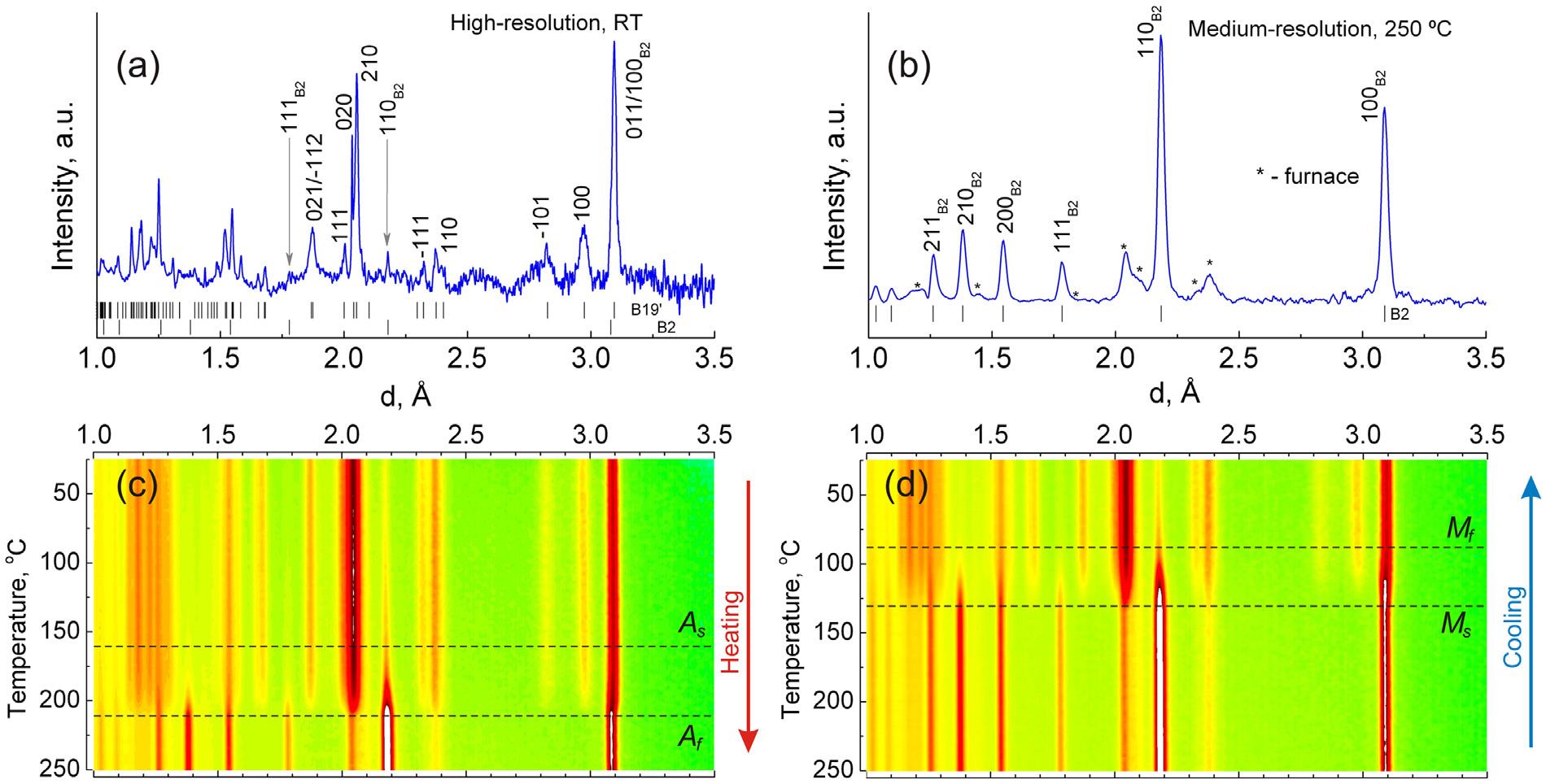Neutron diffraction experiments carried out at FLNP JINR revealed the structural features of high-temperature shape-memory alloys (NiTiHf) upon phase transformations. The results not only explain the reasons for the inconsistency between theoretical and experimental data, but also make it possible to choose the optimal ways to improve the properties of the unique alloys.

Shape memory alloys (SMA), which are called "smart" materials of the future, have the unique ability to "remember", change or recover their original shape when exposed to temperature, mechanical stress, electric current or magnetic field. The shape memory effect in these alloys is due to the occurrence of two stable states of the crystal lattice (martensite and austenite phases) and is achieved through a phase transformation between them, which ideally, proceeds as follows: at a temperature above a certain critical one, the specimen is primarily comprised of an austenite phase (characterized by a certain arrangement of atoms in the alloy), and upon cooling, due to structural changes in the crystal lattice, it transforms to the martensite phase. When the material is in its martensite form, it is soft and ductile and can easily be formed into any shape with a slight mechanical effort. The specimen retains the changes until it is heated to the critical temperature. When heated, it goes through transformation from martensite to austenite and recovers its original shape. This effect was first noticed by the Swedish physicist Arne Ölander in an alloy of gold and cadmium in 1932, and in 1948 Soviet scientists Georgy Kurdyumov and Lev Khandros predicted, and in 1949 discovered the effect in an alloy based on aluminum bronze.
The combination of unusual physical and mechanical properties opens up incredible possibilities for the application of shape memory alloys in a wide variety of fields of science, industry and everyday life. A true "boom" was triggered by the discovery of the shape memory effect in alloys of nickel and titanium (Nitinol, NiTi) by the American scientist William J. Buehler in the 1960s. These alloys are used today in aerospace and automotive industries, in power engineering and electronics, in civil engineering and medicine (medical applications ranging from contraceptive coils and artificial muscles to orthopedic implants, staples for fastening bones and intravascular stents), mining industry (‘smart’ wells) and robotics. However, the range of commercial applications of shape memory alloys is limited by their high cost and relatively low transformation temperatures (below 100°C).
Therefore, researchers are trying to "design" new materials with improved characteristics, using theoretical models that relate the structure of a material at the atomic level to its macro-properties. The next step is to experimentally test the applicability of the models and explain possible inconsistencies with theory.
The addition of a third element improves the properties of shape memory alloys. For instance, NiTiHf ternary alloys, due to their relatively low cost, superelasticity, high strength and high transformation temperatures, are considered the most attractive candidates for practical applications in various industries in the temperature range up to 300°C (for example, in automotive and electrical engineering). However, these alloys have a number of disadvantages such as low ductility and large hysteresis, as well as there are significant discrepancies between experimental data and theoretical predictions for the shape recovery strain.
To find out what caused the significantly more optimistic estimates shown by theoretical models, researchers from China (Institute of Materials Processing and Intelligent Manufacturing) in collaboration with their colleagues from FLNP JINR and the National University of Science and Technology “MISiS” studied samples of these materials using high-resolution neutron diffraction. Structural studies using in situ real-time neutron diffraction experiments have shown that NiTiHf alloys in the initial state are characterized not only by the functional martensitic phase, but also by more than 10% of the austenite phase, which does not take part in thermoelastic transformations with the shape memory effect. Upon heating during the martensite-to-austenite phase transition, the volume of unit cells changes significantly, and hence the volume of the material itself. These processes, in turn, can cause not elastic accommodation of internal stresses, but relaxation through plastic deformation.
High-resolution ND pattern of Ti29.7 Ni50.3 Hf20 alloy at RT
(a) medium-resolution ND pattern measured at 250 °C (b) and 2D visualization of the ND pattern evolution measured upon heating
(c) and consequent cooling (d) in the in situ medium-resolution mode.
“Thus, the discrepancy with theoretical predictions can be explained by the fact that part of the material remains inactive, which is 13% of austenite in the martensite matrix, and does not take part in the martensitic transformation responsible for the shape memory effect. In addition, the partial plastic accommodation of internal stresses caused by large changes during the transformation of the atomic structure of austenite to martensite suppresses the deformation resource inherent in the crystal lattice of the alloy under study. The obtained results will make it possible to choose a strategy for improving the functional properties of alloys, for example, using grain boundary strengthening, solid solution strengthening or precipitation hardening, and thereby achieve the theoretically predicted limits of reversible shape change,” summed up one of the study's authors, Ivan Bobrikov, a researcher from the Frank Laboratory of Neutron Physics.
Volume effect upon martensitic transformation in Ti29.7Ni50.3Hf20 high temperature shape memory alloy. A. V. Shuitcev, R. N. Vasin, XinMingFan, А.M. Balagurov, IvanA. Bobrikov, LinxuanLi, IgorS. Golovin, YunxiangTong. March 2020, Scripta Materialia 178:67-70. DOI: 10.1016/j.scriptamat.2019.11.004
Thermal expansion of martensite in Ti29.7Ni50.3Hf20 shape memory alloy. A. Shuitcev, R.N. Vasin, А.M. Balagurov, L. Li, I.A. Bobrikov, Y.X. Tong, Intermetallics 125 (2020) 106889 https://doi.org/10.1016/j.intermet.2020.106889
Olga Baklitskaya-Kameneva



